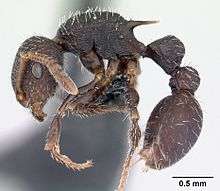Romblonella
| Romblonella | |
|---|---|
 | |
| R. opaca worker | |
| Scientific classification | |
| Kingdom: | Animalia |
| Phylum: | Arthropoda |
| Class: | Insecta |
| Order: | Hymenoptera |
| Family: | Formicidae |
| Subfamily: | Myrmicinae |
| Tribe: | Crematogastrini |
| Genus: | Romblonella Wheeler, 1935 |
| Type species | |
| Rombonella grandinodis Wheeler, 1935 | |
| Diversity[1] | |
| 8 species | |
Romblonella is a genus of myrmicine ants.
Systematics
Romblonella is probably the sister taxon to Stereomyrmex. Closely related genera are Leptothorax and Cardiocondyla.[2]
Biology
Very little is known about these uncommon ants. Most species were found to nest in twigs on trees and to forage on low vegetation.[3]
Description
Workers of R. opaca are about 4 mm long. They have a small sting. R. opaca was described from four specimens found on Romblon Island, Philippines, by Wheeler (1935).[4] However, the species had already been described by F. Smith in 1861 as Myrmica opaca, which had been collected at Tondano, Sulawesi by Alfred Russel Wallace.[5]
R. elysii workers are 2 mm long. They were originally described as Crematogaster from a few workers from the Solomon Islands.[6] R. heatwolei workers are almost 4 mm long.[2]
Only for R. palauensis and R. heatwolei have males been described.[2]
Distribution
Romblonella is found from the Philippines south through New Guinea, with one species known from Australia. The distribution stretches to the islands of the western South Pacific.
Name
The genus is named after the locality where the type species was found.
Species
- Romblonella elysii (Mann, 1919) — Malapina, Big Nggela: Solomon Islands
- Romblonella heatwolei Taylor, 1991 — Wyer Island: Torres Strait: Queensland: Australia
- Romblonella opaca (F. Smith, 1861) — Philippines, Indonesia
- Romblonella palauensis M. R. Smith, 1953 — Auluptagel, Urukthapal, Babelthaub: Palau: Caroline Islands
- Romblonella scrobifera (Emery, 1897)[7] — Aitape, Manus Province, East Sepik Province, Morobe Province, East New Britain Province: New Guinea
- Romblonella townesi M. R. Smith, 1953 — Mount Lasso: Tinian Island: Northern Mariana Islands
- Romblonella vitiensis M. R. Smith, 1953 — Wakaya Island: Fiji Islands
- Romblonella yapensis M. R. Smith, 1953 — Yap Island: Caroline Islands
Images
 Specimen of a Romblonella opaca
Specimen of a Romblonella opaca Specimen of a Romblonella palauensis
Specimen of a Romblonella palauensis Specimen of a Romblonella scrobifera
Specimen of a Romblonella scrobifera
Footnotes
- ↑ Bolton, B. (2014). "Romblonella". AntCat. Retrieved 20 July 2014.
- 1 2 3 Taylor, Robert W. (1991): Notes on the ant genera Romblonella and Willowsiella, with comments on their affinities, and the first descriptions of Australian species. (Hymenoptera: Formicidae: Myrmicinae). Psyche 97: 281-298. PDF
- ↑ Australian Ants Online: Genus Romblonella
- ↑ Wheeler, William M. (1935): Two new genera of myrmicine ants from Papua and the Philippines. Proceedings of the New England Zoological Club 15: 1-9. PDF
- ↑ Smith 1861: 47
- ↑ Mann 1919: 319
- ↑ length c. 3 mm, as Tetramorium scrobiferum, Emery 1897: 587
References
- Emery, Carlo (1897): Formicidarum species novae vel minus cognitae in collectione Musaei Nationalis Hungarici, quas in Nova Guinea, colonia germanica, collegit L. Biro. Termeszetrajzi Fuzetek 20: 571-599. PDF
- Mann, William M. (1919): The ants of the British Solomon Islands. Bulletin of the Museum of Comparative Zoology of Harvard College 63: 273-391. PDF
- Smith, Frederick (1861): Catalogue of hymenopterous insects collected by Mr. A. R. Wallace in the Islands of Ceram, Celebes, Ternate, and Gilolo. Journal of the Proceedings of the Linnean Society of London, Zoology 6: 36-48. PDF
- ITIS: Genus Romblonella
Further reading
- Smith, Marion R. (1953): A revision of the genus Romblonella W. M. Wheeler (Hymenoptera: Formicidae). Proceedings of the Hawaiian Entomological Society 15: 75-80. PDF
External links
 Media related to Romblonella at Wikimedia Commons
Media related to Romblonella at Wikimedia Commons
